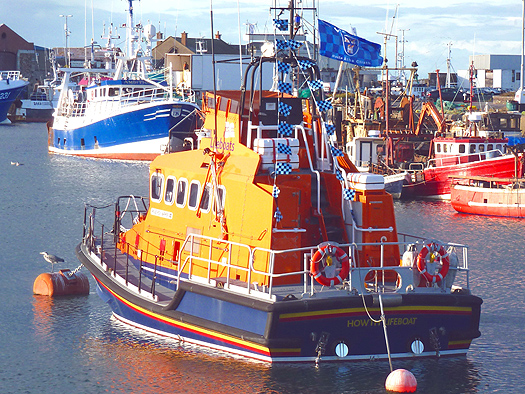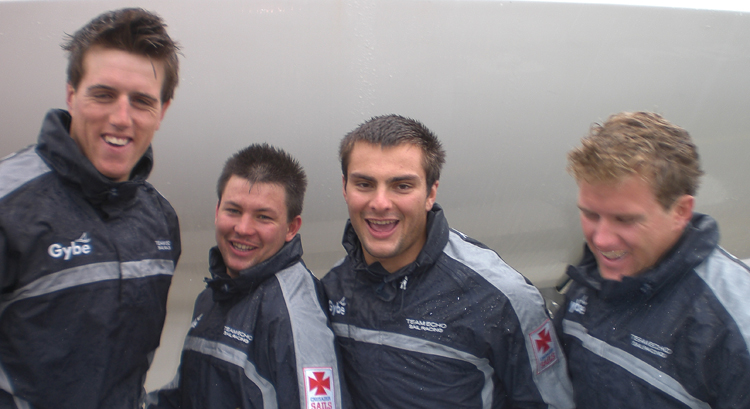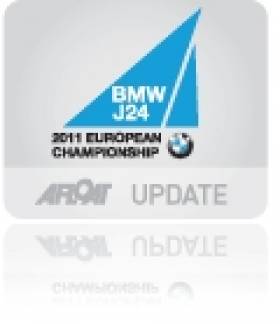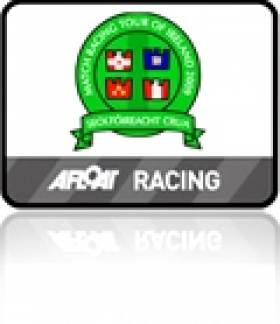Displaying items by tag: Howth
Howth Autumn League Race Three Results
Welsh Kayaker Sets New Irish Sea Crossing Record
According to Canoe & Kayak, last Saturday 2 October Anglesey man John Willacy crossed from Soldier's Point in Holyhead to Howth in Dublin - a distance of 55.8 nautical miles - in 11 hours 19 minutes and 59 seconds.
It's not the first open sea kayaking record set by Willacy, who last year broke the record for circumnavigation of the Isle of Man in 12 hours 38 minutes.
Lack of Wind Forces Cancellation of Howth Autumn League
This morning's second race of the WD 40 sponsored Howth Yacht Club Autumn League was cancelled due to lack of wind.
Howth Lifeboat Shows True Colours
Howth Lifeboat at 1800 hrs the night before the big match - inspite of our photograph we are assured that any Kerry sailors in difficulty on the Irish Sea this weekend will be treated the same as everyone else.
Meanwhile the last manager to lead Dublin into All-Ireland SFC battle has given his blessing to Pat Gilroy's troops as they seek to snare pre-match favourites Kerry and bring Sam back to the capital for the first time in 16 years.Dr Pat O'Neill has savoured the buzz around the city this week and feels "very confident" that the current team can emulate the All-Ireland achievement of his 1995 heroes. Up the Dubs!

Penfold Wins J24 Euro Title in Last Race Decider
Top of the table was 'Reloaded' (Mark Penfold), sailing under US colours, with 34 points, three ahead of the leading European entry 'Il Riccio' (Ian Southworth/Chris McLaughlin) which takes the European Championship trophy.
With the exception of their discard of a 20th in the fifth race, 'Reloaded' was consistently in the top four in most races and had one bullet, while closest rivals 'Il Riccio' had two bullets and only a 9th to discard.
That they had some 28 points to spare over the third placed 'Serco' (Bob Turner) emphasised their dominance over the series. The German champion 'Rotoman' (Kai Mares) was only a point behind in 4th place and won the final race of the regatta while Stuart Jardine, the oldest helm in the championship, had the distinction of winning three races, including the first two races of the final day. Another German boat 'Hungriger Wolf' (Johann Huhn) had six top ten results to earn 6th overall.
Local boat Jibberish (O'Kelly/Wormald/Walsh) enjoyed its best result when finishing second behind 'Stouche' (Jardine) in the seventh race while German entry 'JJone' (Frithjof Schade) was looking at the same transom in the eighth race. The Southworth/McLaughlin crew topped the fleet in the penultimate race followed by the Hungarian boat 'Naviscon' (Farkas Litkey) while 'Serco' took second behind 'Rotoman' in the final race.
Needing to beat their US rivals by several places in the last race to take 1st overall, 'Il Riccio' could only manage an 8th to 'Reloaded's' 5th.
The leading Irish crew was 'Hard on Port' (Flor O'Driscoll, HYC) in 10th overall with 'Jamais Encore' (John-Patrick McCaldin, Lough Erne YC) next best in 17th.
J24 Euros Open in Howth, Strong Winds Cancel Practise Race
The BMW J/24 European Championships were officially opened last night with a ceremony on the forecourt in front of the Howth Yacht Club clubhouse on the podium erected by the sponsor but a practise race scheduled for this afternoon was cancelled due to strong winds.
Last night's openning ceremony featured two top-of-the range BMW vehicles and a motorcycle and a backdrop with the highly appropriate phrase of 'Joy is Plain Sailing' in front of the national flags of the nine competing nations.
With an audience of competitors, supporters and club members, the speakers on the podium were introduced by the 'Master of Ceremonies', Club and Championship Press Officer Graham Smith.
First to speak was Derek Bothwell, Chairman of the Championship Organising Committee, and then the Commodore Roger Cagney addressed the large crowd who has assembled on the forecourt and balcony. They were followed by John Ives, Managing Director of BMW Ireland, the title sponsors, who spoke about BMW's global involvement in sailing, and then Niamh McCutcheon, President of the Irish Sailing Association, spoke on behalf of the ISA and the Irish Sports Council who supported the event.
Jim Farmer, President of the World Council of the International J/24 Class Association, spoke next, and the final speaker was the Mayor of Fingal, Cllr.Gerry McGuire, who welcomed all the overseas visitors to the county and officially declared the Championship open.
Team Echo Win Dublin Match Race Event
After a three round robin series organised by Howth Yacht Club, visting Team Echo, from Poole in Dorest, won Dublin's 2011 Match Racing Open. The team made up of Mark Lees, Toby Yeabsley, Mark Yeabsley and Peter Austin convincingly won the Investwise sponsored series, sailed in J80s with 11 wins and one loss.

Team Echo won the Dublin Match Racing Open
In the second race an unfortunate incident where bowman Peter Austin cut his leg disrupted the usual momentum of the team. an Irish Match racer kindly stepped in as a substitute for the remainder of racing one the first day and regular mainsheet trimmer Toby Yeabsley stepped in as bowman while Peter went to be treated in hospital.
A tie break was required to split the home clubs team - consisting of evelopment squad members skippered by Ryan Scott - from Peter Bayly and Team PN, with the HYC Development Squad taking second 2 wins to 1. Peter showed glimpses of what he can do, the only skipper to take a race form the British team.
Alistair Kissane and Team Pies finished fourth and Audrey Adamson with SailingWest Ladies finished fifth.

Dun Laoghaire's Jay Bourke Wins Etchells Title
It was tight in points at the top end of the Etchells Nationals in Howth in the last weekend of August.
After a protest was resolved Jay Bourke's Northside Dragon from the Royal St. George Yacht Club won on countback from Royal Corinthian visitor Palaver with Dan O'Grady's Kootamundra third.
The top 3 Overall ...
1st Northside Dragon J Bourke RStGYC 10 pts
2nd Palaver D Franks Royal Corinthian YC 10 pts
3rd Kootamundra D O'Grady HYC 12 pts
Squall Puts Paid to First Race of Star Europeans in Dun Laoghaire
Howth Race Officer David Lovegrove opted to send the 27-boat fleet back ashore ahead of the gale that was followed by torrential rain and squalls, a decision, say Royal St. George YC organsiers, that met with the approval of competitors from 17 nations.

Dun Laoghaire's Max Treacy and Anthony Shanks before racing was cancelled yesterday. Photo: Gareth Craig.
By 4pm though the gales and rain had dsisappered and sunny ideal 10-knot conditions returned to Dun Laoghaire, unfortunately just too late for the Stars to resume racing.
Fresh to strong conditions are expected to continue for the early part of the week. Two races are scheduled for tomorrow, starting at 11.30am.
Greath Craig's pics are below and more on the Afloat gallery here.
The 162 gross tonnes tug had served a career of nearly three decades in Dublin Port, after entering service in 1972. Prior to working in Irish waters the 100ft tug spent the previous decade operating in the UK as Appelsider for Lawson-Batey Tugs Ltd who chartered her to Tyne Tugs Ltd. For historical record and photos click HERE.
In 1998 the Dublin Port Company disposed of the Coliemore alongside her running mate Clontarf (1963/178grt) the former Cluain Tarbh, also built from the same Yorkshire shipyard on the banks of the River Humber.
Initially they were towed to Liverpool but they later appeared at Cork Dockyard in 1999. The Clontarf remained there for a year until she was sold to Barcazas Dominicia SA, Santo Domingo in the Dominican Republic. For photo of the tug in far distant waters click HERE. It was intended Coliemore would follow her Caribbean counterpart but her sale fell-through.
The vessel's ownership eventually transferred to Cork Dockyard where her scrap value will pay for her long-term berthing fees. The tug recently made her final short journey under tow from her berth at the former Verolme Cork Dockyard (VCD) to the facilities slipway where work to break-up the vessel began.
Coliemore and her fleet-mates were given the traditional naming theme of Dublin Bay coastal suburbs spelt in Irish. The naming policy was used by the Dublin Ports & Docks Board (DP&DB) which operated the fleet remained until transferred to the Dublin Port Company established in 1997.
The last tugs to carry the traditional names, Ben Eadar (Howth), Cluain Tarbh (Clontarf) and Deilginis (Dalkey) are now up laid-up awaiting to be sold, to read more click HERE.
Between the 14-16th centuries Dalkey Sound became increasingly important as larger vessels with deeper drafts could no longer enter the port in Dublin due to the dangers of constantly shifting sandbanks and swallow channels in Dublin Bay.
The nearest alternative was for vessels to anchor off Dalkey Island and in the relative shelter of Dalkey Sound where cargoes for the capital where transferred to and fro by lighters to the coastline along Dalkey at Coliemore, which became the principle port for Dublin. Some of the cargo was stored temporally in the medieval castles in Dalkey, otherwise it was directly transported by horse and cart across the plateau to the city.
It was not until the 17th century that the issue of accessing the port of Dublin was resolved, with the completion of the harbour walls that enabled shipping to return on a frequent basis. Captain Bligh of the 'Mutiny on the Bounty' completed mapping Dublin Bay in 1803 which became the most accurate chart at the time and this aided to the safety of mariners.
The fortunes of Dublin's shipping trade increased due to the combination of an easier and safer navigational channel and deeper depths along the quaysides. This led to the eventual demise of shipping using Dalkey. The present-day harbour structure at Coliemore Harbour was constructed in 1868 and is home to a humble fleet of recreational boats and a passenger-ferry service to the island.
- Howth
- Dublin Bay
- Dublin Port
- Clontarf
- Dublin Port Company
- dalkey
- coliemore harbour
- Dalkey Island
- Port of Dublin
- Ports and Shipping News
- Cork Harbour News
- Verolme Cork Dockyard
- VCD
- Dalkey Sound
- Mutiny on the Bounty
- Dublin Port Tugs
- Deilginis
- Captain Bligh
- Dublin port tugs for sale
- Coliemore
- Coliemore tug
- Cork Dockyard
- Cork Dockyard Rushbrooke
- Cluain Tarbh tug
- Ben Eadar tug
- Deilginis tug
- Richard Dunston (Hessle) Yorkshire
- River Humber
- Dublin Ports & Docks Board
- DP & DB
- Cork Dockyard shiprepairers
- Irish shipbuilding





































































